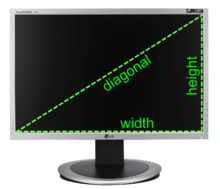- Display size
-
 Diagram comparing various typical screen sizes by width, height, diagonal, area and aspect ratio.
Diagram comparing various typical screen sizes by width, height, diagonal, area and aspect ratio.
On two-dimensional display devices such as computer monitors and television sets, the display size (or viewable image size or VIS) is the actual amount of screen space that is available to display a picture, video or working space, without obstruction from the case or other aspects of the unit's design. The viewable image size (often measured in inches or millimeters) is sometimes called the physical image size, to distinguish it from the "logical image size" (display resolution, measured in pixels) of various computer display standards.
The size of an approximately rectangular display is usually given by monitor manufacturers as the distance between two opposite screen corners, that is, the diagonal of the rectangle. This method of measurement is inherited from the method used for the first generation of CRT television, when picture tubes with circular faces were in common use. Being circular, only their diameter was needed to describe their size. Since these circular tubes were used to display rectangular images, the diagonal measurement of the rectangle was equivalent to the diameter of the tube's face. This method continued even when cathode ray tubes were manufactured as rounded rectangles; it had the advantage of being a single number specifying the size, and was not confusing when the aspect ratio was universally 4:3.
A problematic practice was the use of the size of a monitor's imaging element, rather than the size of its viewable image, when describing its size in publicity and advertising materials. On CRT displays a substantial portion of the CRT's screen is concealed behind the case's bezel or shroud in order to hide areas outside the monitor's "safe area" due to overscan. These practices were seen as deceptive, and widespread consumer objection and lawsuits eventually forced most manufacturers to instead measure viewable size[citation needed]. On cathode ray tube monitors, VIS differs noticeably from the full tube size, which is generally about 25 mm (1 in) larger.
Liquid crystal displays use 100% of their surface to display, thus the VIS is the actual size presented to the viewer.
In the U.S., manufacturers and retailers are allowed to list the tube size, which is misleading and confusing to many customers, especially when comparing both CRT and LCD models together. In many other countries, this practice is prohibited by consumer-protection laws.
Measurements and units
 The practice of measuring display devices by the diagonal is a remnant from the time when cathode ray tubes were used, which basically created circular projections, and any rectangular area derived thereof had a diagonal equal to the circle diameter.
The practice of measuring display devices by the diagonal is a remnant from the time when cathode ray tubes were used, which basically created circular projections, and any rectangular area derived thereof had a diagonal equal to the circle diameter.
The main measurements for display devices are:
- Width and height
- Total area
- The diagonal, usually measured in inches. The diagonal measurement of a display as the actual viewable area is also dependent on the aspect ratio of the display. For a display device of the same area, the diagonal achieves a larger value in a widescreens than compared to more rectangular screen. There is a risk of manufacturers making displays wider than what is actually most convenient in order to make the diagonal achieve a larger value.
Conversion equations
The width and height can be calculated from the diagonal as follows:


, where:
- D is the diagonal
- W and H are taken from the aspect ratio as W:H, or, alternatively, by the screen resolution given by rows of pixels (assuming square-shaped pixels).
Conversion charts
These are charts of some common sizes of LCDs with varying aspect ratios and their actual viewable area.
Width, height and viewable area from diagonal measurement and aspect ratio, rounded to centimetres Diagonal 5:4 4:3 8:5 16:9 (in) (cm) w (cm) h (cm) A (cm²) w (cm) h (cm) A (cm²) w (cm) h (cm) A (cm²) w (cm) h (cm) A (cm²) 7 18 14 11 154 14 11 152 15 9 142 15 9 135 10 25 20 16 315 20 15 310 22 13 290 22 12 264 11 28 22 17 381 22 17 375 24 15 351 24 14 334 14 36 28 22 617 28 21 607 30 19 568 31 17 527 15 38 30 24 708 30 23 697 32 20 652 33 19 620 17 43 34 27 910 35 26 895 37 23 838 38 21 797 19 48 38 30 1136 39 29 1118 41 26 1047 42 24 995 20 51 40 32 1259 41 30 1239 43 27 1160 44 25 1103 21 53 42 33 1388 43 32 1366 45 28 1279 46 26 1216 22 56 44 35 1523 45 34 1499 47 30 1403 49 27 1334 23 58 46 36 1665 47 35 1638 50 31 1534 51 29 1458 24 61 48 38 1813 49 37 1784 52 32 1670 53 30 1588 25 64 50 40 1967 51 38 1935 54 34 1812 55 31 1723 26 66 52 41 2127 53 40 2093 56 35 1960 58 32 1864 27 69 54 43 2294 55 41 2258 58 36 2114 60 34 2010 28 71 56 44 2467 57 43 2428 60 38 2273 62 35 2161 29 74 58 46 2647 59 44 2604 62 39 2439 64 36 2318 30 76 60 48 2832 61 46 2787 65 40 2610 66 37 2481 31 79 61 49 3024 63 47 2976 67 42 2787 69 39 2649 32 81 63 51 3223 65 49 3171 69 43 2969 71 40 2823 33 84 65 52 3427 67 50 3372 71 44 3158 73 41 3002 34 86 67 54 3638 69 52 3580 73 46 3352 75 42 3187 35 89 69 56 3855 71 53 3794 75 47 3552 77 44 3377 36 91 71 57 4079 73 55 4013 78 48 3758 80 45 3573 37 94 73 59 4308 75 56 4239 80 50 3970 82 46 3774 38 97 75 60 4544 77 58 4472 82 51 4187 84 47 3981 39 99 77 62 4787 79 59 4710 84 53 4410 86 49 4193 40 102 79 63 5035 81 61 4955 86 54 4639 89 50 4411 41 104 81 65 5290 83 62 5206 88 55 4874 91 51 4634 42 107 83 67 5552 85 64 5463 90 57 5115 93 52 4863 43 109 85 68 5819 87 66 5726 93 58 5361 95 54 5097 44 112 87 70 6093 89 67 5995 95 59 5614 97 55 5337 45 114 89 71 6373 91 69 6271 97 61 5872 100 56 5582 46 117 91 73 6659 93 70 6553 99 62 6136 102 57 5833 47 119 93 75 6952 96 72 6841 101 63 6405 104 59 6090 48 122 95 76 7251 98 73 7135 103 65 6681 106 60 6352 49 124 97 78 7556 100 75 7435 106 66 6962 108 61 6619 50 127 99 79 7868 102 76 7742 108 67 7249 111 62 6892 The aspect ratio of 5:3 is found on several smartphones, such as those having a screen resolution of 480x800 pixels:
Diagonal 5:3 (in) (cm) w (cm) h (cm) A (cm²) 3.5 8.9 4.6 7.6 35 3.7 9.4 4.8 8.1 39 4 10.2 5.2 8.7 46 4.3 10.9 5.6 9.4 53 5 12.7 6.5 10.9 71 Categories:- Display technology
Wikimedia Foundation. 2010.

